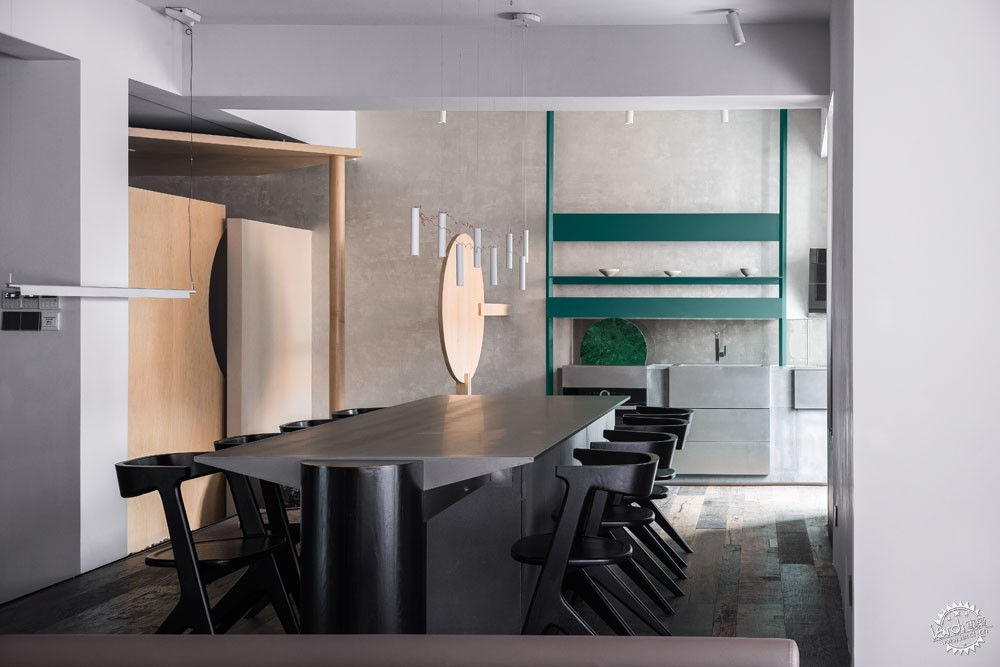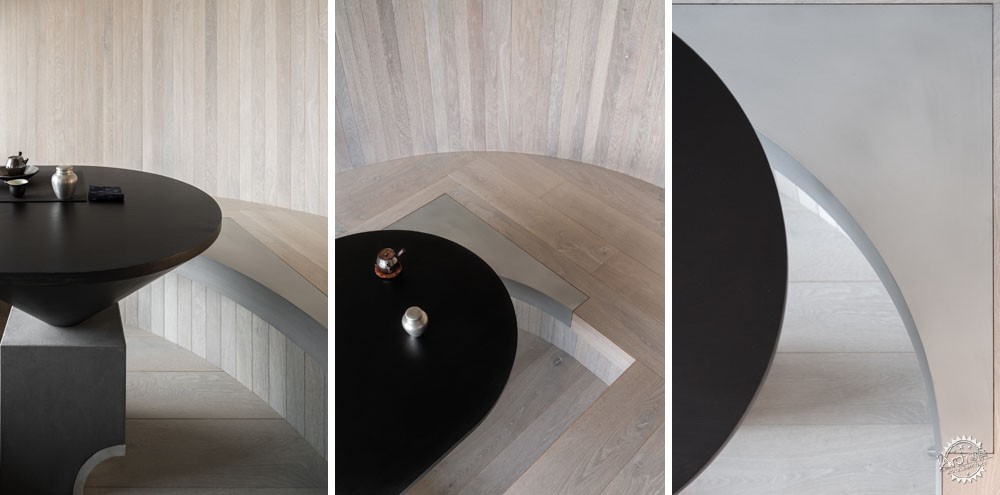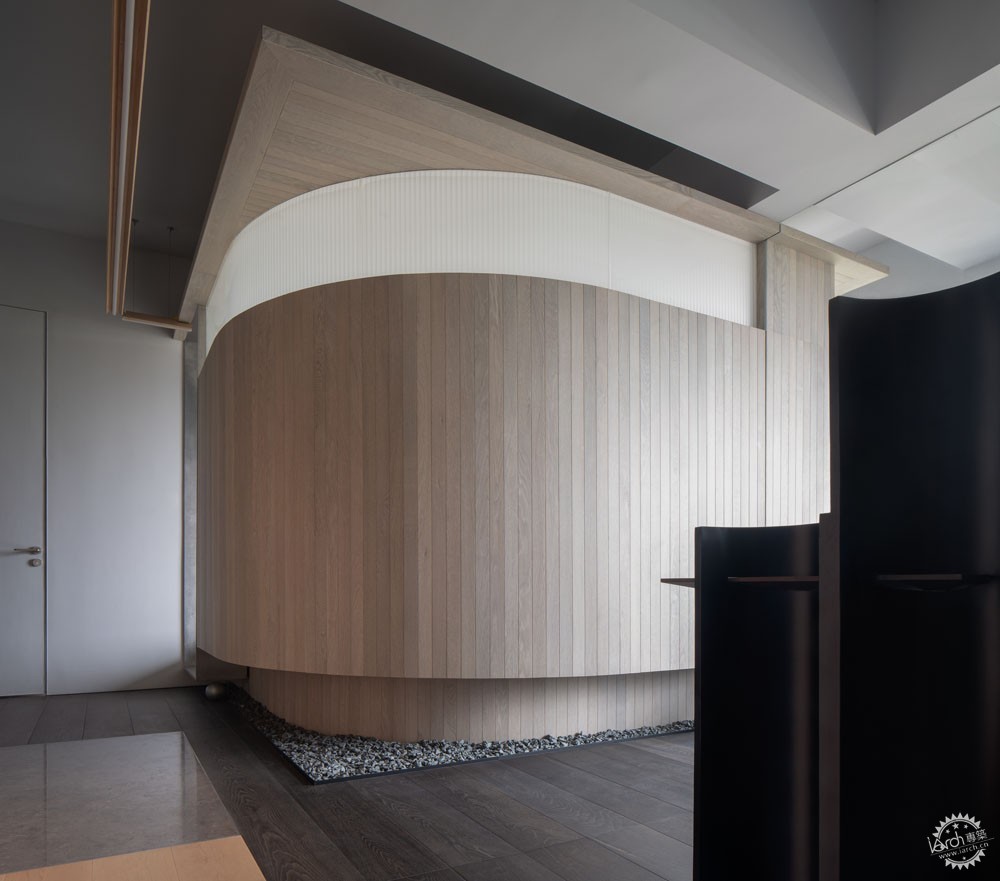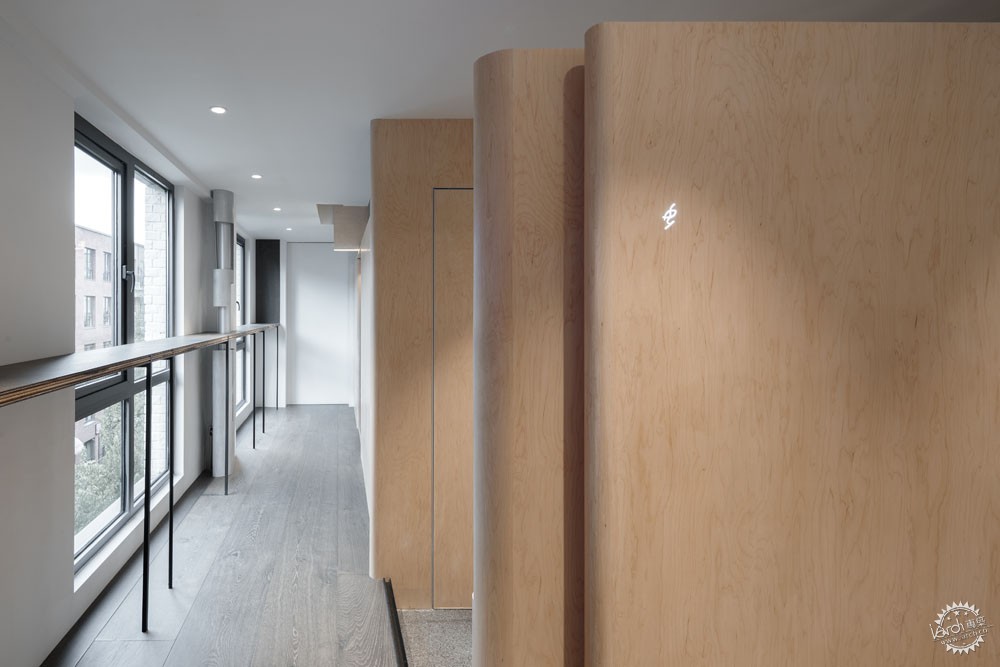Office Space of Ugan Concept Me and My Experience of Forest-Quality
感物是一个木地板品牌,现成有很多木材可用,却反倒成为了我们设计的难题:怎么营造一个“木质性空间”而不是“木质空间”,让“木质”成为一种状态,一种氛围,而不只是“材料”和“材料带来的功能”?就像如果身处在森林里就不会过多的以物化的方式来关注树木,而更会由树木在其环境下围绕的那种自来的整体性:气觉,风触,光斑,声幽等,产生自我的觉察,这样的觉察不会来自他处,便足以被我们称之为:森林性感受……
As a wooden floor brand, Ugan Concept has met a designing aporia with huge amounts of wood available: how to construct “a space of wood quality” instead of “a wooden” space, making “the quality of wood” a state and an atmosphere rather than “a material” and “functions of the material”? It’s like being in the forest, we would not concern about trees in a materialized way; instead, we will have self-perception aroused by the integrity generalized by the surroundings in which trees grow: the sense of smells, the touch of winds, the spots of lights, the distance of sounds and so on. The perception won’t come from anywhere else. We may call it “the experience of forest-quality”.

入口/Entrance
森林,若抛开其生物特性和自然属性,按我们人类对空间的思维习惯,是没有明显的区域和功能划分的,身入其中时,我们既不会按照不同植被间的分层来识别自己所在的区域,也不会根据特有的路径走向某个目标,这就是所谓的无边界感吧。
According to our thinking habits about space, forest, without its biological characters and natural features, has no evident division in area and function. When we are in the forest, we would not identify the area we are in according to layers of different vegetation, nor walk towards a particular target along certain paths. This may be the so-called “the sense of boundarylessness.”

入口处不用门庭反而用了一个抽象的亭子暗示其流通性,让由外而内的心理感受,自然发生;相反地,我们把原本在建筑里作为“半阻隔”用的重要部件——窗户进行部分拆除并介入了一个新的容器——茶室,进而地,其由内而外的精神也模糊了内部(办公空间)与外部(庭院)的关系。
在整体空间中,为了让其形成一种回路,把原本处在核心交通区的卫生间的隔墙打穿,使过道沿着窗户直通会议室,只用一个隐形门阻隔,让每一处都能相互渗透。
At the entrance, in order to indicate its fluxility, an abstract pavilion is used rather than a gate and a courtyard; thus, the affection will be aroused naturally from outside to inside. On contrast, we partly remove the window, which was an important part functioning as a half partition in the building, and design a new container – a tearoom, which blurred the relationships between the interior (office) space and the exterior (courtyard) space with its spirits of “from inside to outside.” To make it a loop in the whole space, we removed the partition walls of the bathroom in the core area of traffic and design an invisible door through which the corridor is directly linked with the meeting room with windows on one side. In this way, all the details can permeate with each other in the space.





前庭/aisle
除了物理上的,那些在使用中常常因为功能或是视觉盲区而被我们忽略的区域,同样会变成某种难以逾越的边界,让我们无法靠近。在这个空间中,若指入口左边的角落、室内柱梁、隔墙上下沿、转角等皆如是。于是,我们物化它们并使之产生某种节奏感,让这些看上去不为何物的造型,一并成为了这个空间的“标志性构筑物”。
Besides physical boundaries, areas that are often neglected because of their functions or their positions in the visual fade zone can also become a kind of boundaries that are difficult to pass, keeping us in distance. In this space, such areas are everywhere – at the corner on the left of the entrance, the pillars and beams, the high and low edges of the partition walls, corners, etc. Therefore, we materialize them and give them some rhythm, making those meaningless shapes into “symbolic constructive elements” of the space.




中庭/hallway





侧庭厨房/Dinning room
在都市化的生活方式中,我们对事物甚至对自我的精神感知渐渐退化,那么,如何在保证功能的同时尝试着用那几个“节点”来诱发某种感受而强化自我意识,成为了设计的重心。亭子上的木灯会指引你走向茶室而不是你期待的其他地方,你会因此失落还是兴奋 ? 男女卫生间的洗手台下水连接着小的水景池, 里面的人在洗手,外面的人会看见“脏水”的景观……旋转水柜,立体木幕布,水龙头咬合桶,毛巾镜子挂梁,马桶盒子,景观木承台桌、员工办公桌景观等等,这些“节点”,它们就像我们生活历程里印象深刻的那几个“事件”,我们只记得“感受”,却无法还原事情的真相;有时候,我们需要和“它”独处一会儿。我们将这些记忆碎片堆叠在空间里,让使用者与它产生对话。
In urban lifestyle, our spiritual perception about things and even ourselves are gradually degenerating. Then, the emphasis of the design is how to attempt to use the several “designing points” to arouse certain experiences in order to consolidate self-awareness while ensuring their functions. The wooden light hanging on the pavilion will lead you to the tearoom rather than other places that you are expecting, will you be disappointed and excited? The small waterscape linked to the outfall of the washbasin in the bath room will present the scene of “used water” from the outside when someone is washing hands inside… the revolving water tank, the three-dimension curtain, the bucket inlaid with tap, the hanging beam of towel and mirror, the case of stool, the wood bearing landscape desk, the staff desk-scape, etc., all those “designing points” are like those several impressive “events” in our life course, which we can remember its “experience”, but we cannot reshape its truth. Sometimes, we need to be left alone with “it”. We pile up all the fragments of memories in the space for people who will use it to have dialogue with.



茶室/tea house



区域之间/area
设计其实都是依托于人而存在的,我们在与空间及其内部物件“发生关系”的时候,它才作为它的功能而存在并带给人不同的体验。这一次,我们更多关注人的 感受,无论是身体上还是心理上。
Design makes significance on the basis of people’s existence. Only when we are “relating” to the space and objects in the space, could it exist and bring various experiences to people with its function. Here and now, we concern more about people’s experience, both physically and mentally.






设计节点/design detail





构筑物各部/unti






办公区细部/Detail


洗手池/hand washing sink


会议室/meeting room

阳台 balcony
项目图纸



项目名称:感物 品牌中心
建筑师或者建筑公司:将究建筑设计事务所
项目地点:中国 杭州
项目业主:Ugan concept感物
项目类型:办公
主创设计:蔡俊林
设计团队:徐寅、李金良
项目面积:约600 M2
完成时间:2018.08
摄 影 师:邵峰、刘宇杰
Project Name: Brand Center of Ugan Concept
Architect or Company: Jiangjiu Architecture
Project Location: Hangzhou, China
Project Proprietor: Ugan Concept
Project Type: Office
Creative Designer in Chief: Cai Junlin
Design Group: Xu Yin, Li Jinliang
Project Area: about 600m2
Project Competed Time: Aug. 2018
Photographer: Shao Feng, Liu Yujie
来源:本文由将究建筑设计事务所提供稿件,所有著作权归属将究建筑设计事务所所有。
|
|
